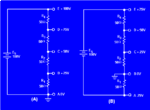probus
Newbie level 4

Hello Dear All,
I have a 220V to 50V transformer. I wanted to build a AC rectifier for it to get 50V DC. Then, I have connected a full wave bridge diode and two pieces of parallel 100V, 1000uF electrolytic capacitors together.
My problem is that; when I measure voltage of the transformer, it is 50V AC, ok. But the voltage of the rectifier is 68V DC.
Why it is 68V? Would you please help me about the problem?
I have a 220V to 50V transformer. I wanted to build a AC rectifier for it to get 50V DC. Then, I have connected a full wave bridge diode and two pieces of parallel 100V, 1000uF electrolytic capacitors together.
My problem is that; when I measure voltage of the transformer, it is 50V AC, ok. But the voltage of the rectifier is 68V DC.
Why it is 68V? Would you please help me about the problem?






